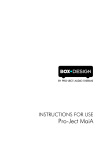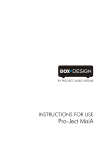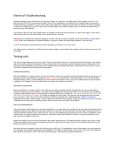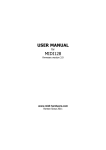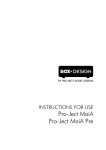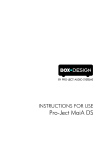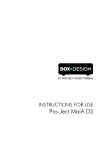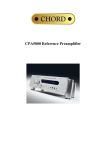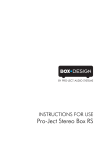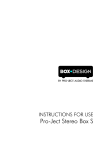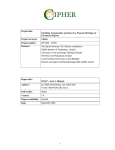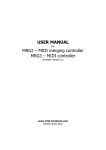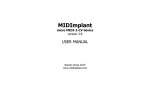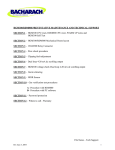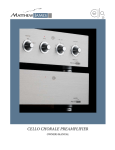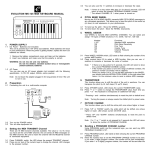Download USER MANUAL - MIDI hardware
Transcript
USER MANUAL for MIDI128 rev.F – MIDI keyboard controller firmware version 2.x www.midi-hardware.com Roman Sowa 2009 Overview This model is the heart of average scale consoles with multiple keyboards and various functions. By itself it scans 128 contacts and generates appropriate MIDI notes. It cannot translate the velocity (or dynamics) of the hit key into MIDI, but this parameter can be set with a knob or pedal. If 128 keys (in 2 keyboards) is not enough, you can connect 2 expanders that take care of additional keyboards. There are several expander sizes available: for 32, 64 and 128 keys. This way, up to 6 keyboards can be used, or 384 keys. In addition to the keyboards, there are 7 inputs for potentiometers to work like in typical MIDI knob box. Their functions are user configurable to some extent. Features • • • • • • • • • • 2 on-board inputs for 64-keys keyboards expandable by 2 optional scanners, each for 32, 64 or 128 contacts velocity of MIDI notes determined by a pot independent transposition for all keyboards in steps of 1 semitone and 1 octave MIDI channel set separately for each keyboard and each CC (potentiometer) any MIDI Continuous Controller defined independently for each potentiometer Program Change by 2 +/- buttons, separate count for each keyboard MIDI activity indicator all settings stored in non volatile memory, remain after power cycle factory settings recall of default transposition, MIDI channels and CC types Layout J1 J2 J3 J4 J5 J6 J7 J8 – – – – – – – – first keyboard (8x8 diode matrix interface) second keyboard (8x8 diode matrix interface) scanner/expander input MIDI cable connector scanner/expander input special functions connector connector for potentiometers or control voltages power supply Power supply Recommended power supply range is between 6 and 12V DC, and it must be connected to the screw terminals (J8) as indicated in the drawing above. Connecting power in reverse will not damage the board, but it works only while proper polarity is maintained. It is possible to run this board even from lower voltage, but its operation is not guaranteed then. Current consumption doesn't exceed 3mA with 2 expanders connected and no potentiometers. If there are 20k pots, current consumption will rise by 0.25mA per pot. Connecting keyboards Keyboard switches are connected to 2 keyboard interfaces (J1 and J2) and with optional keyboard scanners, or in another words - expander boards, which is described in Expanders section later in this manual. Two onboard 8x8 scanner drivers can be used if the keyboard has “scanning diode matrix”, that's simple circuit, made of diodes forming electric XY array of 8 rows and 8 columns. Usually all modern keyboards are equipped with it. In fact it is integral part of the contacts board found beneath the keys. Those kind of keyboards can work directly with MIDI128 controller, as well as optional DMS-2K scanner. Older keyboards, and especially those used in old analog organs, usually don't have such a thing, so in order to use 8x8 scanner, you must solder the diodes to your contacts, according to schematics on the right. Table below shows scanner needed for different keyboards: Keyboard type MIDI128 DMS-2K Independent switches, no ◊ connection to any circuitry Switches organized in 8x8 ● matrix, with diodes Switches organized in 8x8 ◊ matrix, no diodes Switches 5x12 and other (Yamaha, Casio) One common rail for all switches BBS PEDSCAN ● ◊ ‡ ● ‡ ◊ ‡ ● ● - can be used directly ◊ - with external diode matrix ‡ - some rewiring of original contacts circuit may be required On the MIDI128 controller, as well as DMS-2K expander, each 16-way connector covers one keyboard. Schematic on the right side of this page shows compatible diode matrix. Connecting potentiometers Pot inputs can be used as continuous controllers for things like volume, modulation etc. Usually those inputs would be connected to potentiometers, but it's possible to use them as analog inputs with range of 0..+5V. Applying voltage of 0V causes MIDI128 to generate CC with lowest value, while +5V generates highest possible value of assigned MIDI parameter. There are 8 available inputs, 7 of them user configurable in terms of controller type and MIDI channel. Potentiometers are connected to 1 smaller black connector (J7). 8th input (pin 10) is dedicated for MIDI notes velocity setting. Below is schematic of potentiometers connections: The pinout for J7 is as follows: – – – – 1 Vcc, connect to upper terminal of all 8 pots 2 GND, connect to lower terminal of all pots 3-9 CC inputs, connect wiper terminals of CC pots 10 velocity input, connect wiper of the pot controlling notes' velocity If you don't use all 8 potentiometers, it is recommended to connect unused inputs to VCC (pin 1 of J7). It's quite safe to leave them open, but in some cases it may result in unwanted MIDI CC messages. The potentiometers must be linear taper (non audio). Recommended resistance value is 10-50kohms. Special functions There can be numerous features ordered, but standard set is just transposition and channel change. All of them are available on small 10-pin connector marked as J6 in the layout diagram. They are organized as follows: 2 GND 1 VCC 4 transpose +1 3 transpose -1 6 octave +1 5 octave -1 8 channel +1 7 channel -1 10 prog. ch. +1 9 prog. ch. -1 This is the look of the pins if the J6 was rotated left by 90 deg. from position shown in the layout diagram. The numbers in this table correspond with wire number if standard flat cable with IDC plug is used Transposition Each usage of transposition buttons shifts the last played keyboard in one semitone steps. Transposition is achieved by shorting pins 2 and 4 for sharp, or 2 and 3 for flat. There are inputs for only 2 “buttons”, and they affect last played keyboard. So if you want to change e.g. starting key of pedal board, play any note with pedals, and then press one of the transpose buttons to get desired shift. To reset transposition to default state (C, 65.4Hz, MIDI note 36), press “transpose” +1 and “transpose -1” simultaneously. The transposition is also used to set CC number for a chosen potentiometer, and starting Program Change number in case of split keyboard. There mustn't be any keys pressed while setting transposition, neither any potentiometer cannot be touched. Octave Each usage of octave buttons shifts the last played keyboard one octave up or down. Octave transposition is achieved by shorting pins 2 and 6 for one octave up, or 2 and 5 to for one octave down. There are inputs for only 2 “buttons”, and they affect last played keyboard. So if you want to change octave of certain keyboard, play any note with it, and then press one of the octave buttons to get desired shift. The octave is also used to set CC number for a chosen potentiometer, and starting Program Change number in case of split keyboard. There mustn't be any keys pressed while setting transposition, neither any potentiometer cannot be touched. MIDI Channel Channel of each keyboard and CC/potentiometer can be set independently. Shorting pins 2 and 8 increments the MIDI channel used by last played keyboard, or last moved potentiometer. Shorting pins 2 and 9 decrements the channel. There are inputs for only 2 “buttons”, and they affect last played keyboard or last used potentiometer. So if you want to change e.g. channel of pedal board, play any note with pedals, and then press one of the channel buttons. Likewise, to change MIDI channel used by one of the CCs, simply turn the knob a little and use the channel buttons to set appropriate channel. When using split keyboards, you can set independent MIDI channel for Notes part and Program Change part. Channel settings will affect the part, that was used last. There mustn't be any keys pressed while setting MIDI channel, neither any potentiometer cannot be touched. Program Change Those 2 pins are utility to choose different presets/patches/programs in each keyboard/channel. There are program counters independent for each keyboard. If you play one keyboard and want to change Program, short pins 2 and 10 to jump to the next one from last used for that keyboard. E.g. If last time it was Program 17 (Drawbar Organ according to GM), the next one generated Program Change message setting program will be 18 - Percussive Organ. Factory Settings Recall At any time standard settings of transposition, MIDI channels and CC types can be recalled. That happens when you simultaneously press 4 buttons: transpose +1, transpose -1, octave +1, octave -1, or in another words, pins 3,4,5,6 shorted to GND (pin 2). Factory settings are as follows: – starting note in each keyboard is #36, that is C, 2 octaves below middle one. – Channels 1, 2 are assigned to keyboards scanned by MIDI128 at connectors J1 & J2, first expander connected to J5 has channels 3 & 4, second expander, connected to J3 works with channels 5 & 6. – all 7 potentiometers are working as Channel Volume (#7) in channels 1-7 Continuous Controllers As a standard, all 7 CC pots are configured as Volume (CC #7) in channels 1,2,3,4,5,6,7. This is default setting, but can be altered by the user, using transposition, octave and channel change buttons described in previous section. To change CC to other parameter than Volume, turn the pot in question to tell the controller board that this pot will be altered. Then use transposition (change by 1) and octave (change by 12) buttons to change it into desired CC number. For example to change from volume (CC#7) to Modulation (CC#1) you need to press “transpose -1” 6 times. To change it again from Modulation, to e.g. Expression (CC#11), press “octave +1” once – that turns into CC#13 - and then “transpose -1” twice to have CC#11. At any time you can go back to default setting for chosen pot by turning it a little and then pressing simultaneously “transpose +1” and “transpose -1”. This will setup this pot as Volume (CC #7). MIDI channel of the specified potentiometer can be changed in the same way, by turning the knob and using channel change buttons. Those settings are written in internal nonvolatile memory and will remain after the board is powered up again next time. Velocity input There is one special potentiometer input, at pin 10 of J7, that cannot be used as CC, instead it's considered as velocity input for all notes generated by the MIDI128 board and associated expanders. Velocity data of MIDI note is the information about the force or speed a key was hit. This board, as well as all expanders/scanners, don't measure that force/speed, in another words, they are not velocity sensitive. But to have at least something, you can use the velocity potentiometer to alter velocity of the notes during playing to have some way of expression. Activity indicator Small green LED on MIDI128 board flashes whenever any MIDI message is generated by the board. It's easy to see if the board works and if MIDI messages are generated only when you want them to. It should be shortly flashing whenever any key on entire system is pressed or released, and while the potentiometers are rotated. This indicator is not intended to be wired to the panel by soldering wires to it. It's only there for troubleshooting aid during installation. Expanders MIDI128 controller board works only with 2 keyboards, but it can be expanded by 2 additional controllers. Depending on their size, the whole system can cover up to 6 keyboards or 384 keys over single MIDI socket. Currently there are 3 sizes available: 32, 64 and 128 keys, the last one is also a dual diode matrix scanner and has the 128 keys split into 2 keyboards. Type of the scanner needed is determined by keyboard size and the way how switches are organized. Connection between keyboard scanner and MIDI128 mainboard is always the same, regardless of the type of scanner. MIDI settings of those keyboards can be changed by the user after all connections are in place. 32-keys expander - PEDSCAN-X Pedal board controller takes care of 32 keys. It's very small board that can be fitted inside pedal board, and it connects to the main board via supplied 4-wire cable from J2 connector. Switches must be organized in 4x8 diode matrix. Details are shown in schematic below. numbers 1-12 at the right side of the schematic must match the numbers on the PEDSCAN-X board diagram. The groups of 8 switches with 1 common lead must be separate. In case of keyboard with 1 common bus bar going through entire keyboard, you have to cut the bar every 8th key. 128-keys expander - DMS-2K For increased number of keys, you may use DMS-2K, adding another 128 inputs. Layout is shown on next page. There are two 16-way connectors, that usually are used to connect diode-matrixed keyboards. Smaller connector marked is used to connect it with main controller board - MIDI128. The same diode matrix boards can be used. Go to “Connecting keyboards” paragraph for details about diode matrix. J1 – connector of 1st group of keys (1 to 64) J2 – connector of 2nd group of keys (65 to 128) J3 – connector linking this board with the main board Close to J3 is little activity indicator, that blinks every time a note is played or released in a keyboard connected to this board 32 and 64 keys scanner - BBS64X, BBS32X There's another family of keyboard scanners, especially suitable for keyboards with single rod used as common bus for all switches in entire keyboard. This one does not use diode matrix, and can be used with almost any type of switch arrangement, it can also be controlled by logic gates. The BBSX boards come in 2 variants. They can work with either positive or negative keying, which means that key pressed is represented by 0V, or +5V, but proper BBS version must be selected when placing order. The board can have less 16-pin connectors available, covering only 32 keys. It's then called BBS32X. In case of the big, 64-keys version, keyboard is connected to four 16-pin connectors - J1, J2, J3 and J4 shown on the next page. Each of them covers 16 keys. The key contacts can have one common buss bar (with GND), or it can be driven from logic IC outputs. 0V at an input means “key pressed”, +5V at input or left open means “key released”. The BBS board can be also ordered with reversed logic, i.e. positive voltage at input means “key pressed”, 0V - “key released”. Keyboard should be connected to four 16-pin headers according to the diagram on the next page. It's best to use 4 IDC connectors and 16-wire flat computer grade cable. Each cable connects to 16 consecutive keys. Connection of all keys to pins in BBS64X is also shown in diagram on the next page. LAYOUT 64 keys chainable scanner - BBS-1K This one has the same functionality as BBSX boards described above, but adds a few interesting features. For basic functionality and connections description please refer to BBS64X description, here are only outlined the differences between those 2 boards. BBS-1K has daisy-chain input, which allows to pack more scanners into the system. You can use 4 BBS-1K boards, but only 2 BBSX board with MIDI128. It also has a bit different connector layout, but all 4 connectors for ribbon cable are the same. In contrary to BBSX, this one comes always in 64-inputs version, there's no smaller one. Each black connector covers 16 keys, and little sticker on the board shows what range of inputs are assigned to each connector. This is also explained in the drawing below. BBS-1K must be connected towards MIDI128 with 4-way connector indicated above as "OUT". The connector marked as "IN" is for the purpose of adding next optional scanner. There can be only 2 keyboard scanners (BBS-1K or other) connected in one chain. If third keyboard scanner is used on one input, it will behave like paralleled inputs of 2nd BBS-1K in the chain.










